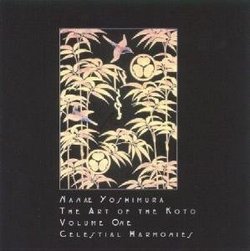Exceptional clarity, nuance and rare beauty
Jeff B Defty | Eugene, OR United States | 07/09/2002
(5 out of 5 stars)
"I have more than three dozen recordings of traditional Japanese music in my collection, and this is one that stands out for its purity, musicality and outstanding recording quality. Yoshimura's playing is always definitive, subtle and highly nuanced. "Chidori" is particularly beautiful, with the instruments and vocals carefully placed in the stereo field to evoke a strong sense of live presence. If you can only afford one recording of koto music, buy this one."
The Best Available
Edward C. Carpenter | San Elizario, Texas | 06/21/2006
(4 out of 5 stars)
"The selections on this release are excellent, and the quality of sound is quite good. Yoshimura is talented. At times her performance is somewhat cooler and less inspired than other renderings I have heard. In my opinion, the best recorded koto music is from a Nonesuch Explorer Series LP which never made it to CD format. It's also available as an audio cassette. How unfortunate. Still I recommend looking for it. It's entitled: The Koto Music of Japan, performed by masters Hagiwara, Hatta, Kitagawa, and Kikusui. It is exquisite. Don't be fooled by two releases currently available that have the same title. The other Nonesuch releases by Ensemble Nipponia are also very good."


 Track Listings (5) - Disc #1
Track Listings (5) - Disc #1